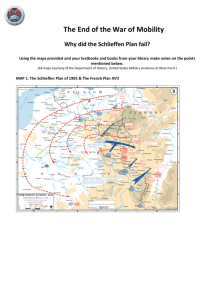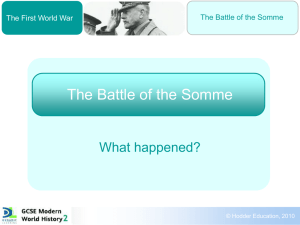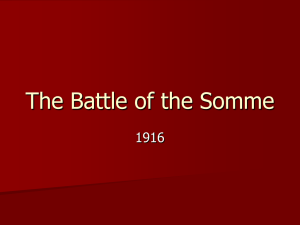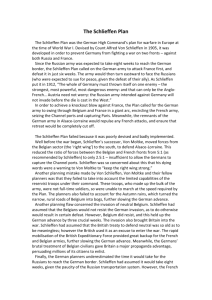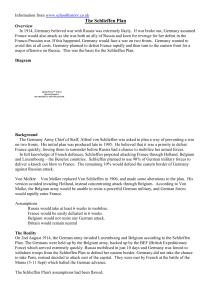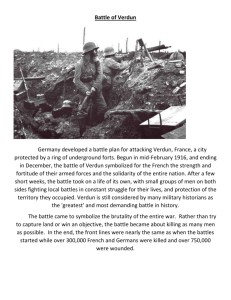File
advertisement
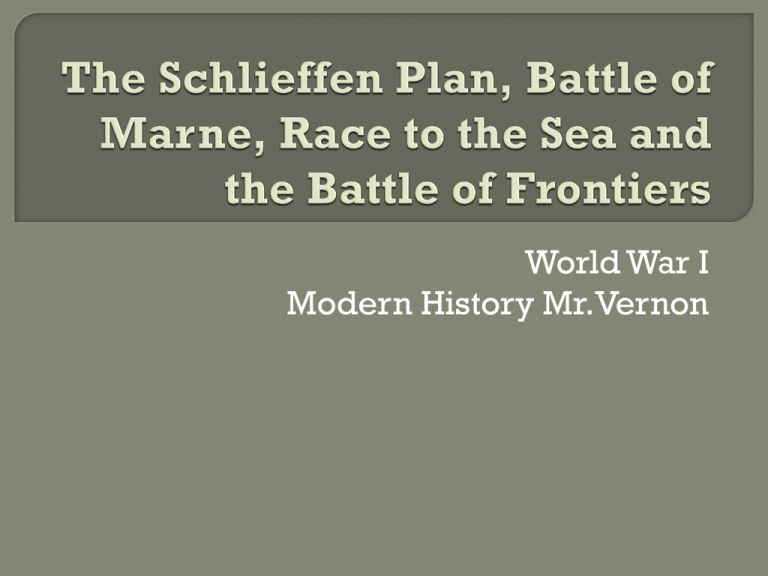
World War I Modern History Mr.Vernon Was the German General Staff's early 20th century overall strategic plan for victory in a possible future war where it might find itself fighting on two fronts: France to the west and Russia to the east. The First World War later became such a war with both a Western Front and an Eastern Front. The plan took advantage of expected differences in the three countries' speed in preparing for war. In short, it was the German plan to avoid a two-front war by concentrating their troops in the west, quickly defeating the French and then, if necessary, rushing those troops by rail to the east to face the Russians before they had time to mobilize fully. The Schlieffen Plan was created by Count Alfred von Schlieffen and modified by Helmuth von Moltke the Younger after Schlieffen's retirement. It was Moltke who actually put the plan into action, despite initial reservations about it. In modified form, it was executed to near victory in the first month of World War I; however, the modifications to the original plan, a French counterattack on the outskirts of Paris (the Battle of the Marne), and surprisingly speedy Russian offensives, ended the German offensive and resulted in years of trench warfare. The plan has been the subject of intense debate among historians and military scholars ever since. Schlieffen's last words were "remember to keep the right flank strong", a request which was watered down by Moltke. The Battle of the Marne was a First World War battle fought between 5 and 12 September 1914. It resulted in an Allied victory against the German Army under Chief of Staff Helmuth von Moltke the Younger. The battle effectively ended the monthlong German offensive that opened the war and had reached the outskirts of Paris. The counterattack of six French field armies and one British army along the Marne River forced the German Imperial Army to abandon its push on Paris and retreat north-east, setting the stage for four years of trench warfare on the Western Front. Over two million men fought in the First Battle of the Marne, of whom more than 500,000 were killed or wounded. French casualties totalled 250,000, 80,000 of them dead, while British casualties were 13,000, 1,700 of them dead. The Germans suffered 220,000 casualties. Of note, the French poet Charles Peguy was killed the day before the beginning of the battle. Is a name given to the period early in World War I when the two sides were still engaged in mobile warfare on the Western Front. With the German advance stalled at the First Battle of the Marne, the opponents continually attempted to outflank each other through north-eastern France. This brought the forces to positions prepared under British Admiralty guidance, on the North Sea coast in Western Belgium. The nature of operations then changed to trench warfare, which is very large scale siege warfare. This produced a continuous front line of trench fortifications more than 200 miles long, which by the following Spring extended from the coast to the Swiss border. The Race to the Sea began in September 1914 in Champagne, at the end of the German advance into France, and ended at the North Sea in November of that year. In the battles fought in Picardy, Artois and Flanders, neither side could gain the advantage, and with repeated attempts to find the open flank, the line was extended until it reached the coast. The term "Race to the Sea" suggests that all the forces began in Champagne: in reality, significant German Army units arrived from Belgium, after the fall of Antwerp, and much of the British Expeditionary Force (BEF) arrived from England by way of the Channel coast of France. The movement towards the North Sea was the result of continual failed attempts at flanking 0 Was a series of battles fought along the eastern frontier of France and in southern Belgium shortly after the outbreak of World War I. The battles represented a collision between the military strategies of the French Plan XVII and the German Schlieffen Plan. The British Expeditionary Force (BEF) fought a relatively minor battle at Mons which, by virtue of its position facing the critical right wing of the invading German army, had a significance that far exceeded the number of men engaged or casualties inflicted. The defeat of the French offensive in the Battle of the Ardennes led to a general retreat to the Marne River where the French and British forces regrouped for the defense of Paris. By the end of August, the French Army had suffered 75,000 dead of which 27,000 were killed on 22 August alone, making it a day to rival the first day on the Somme for bloodshed. Total French casualties for the first month of the war were 260,000 of which 140,000 were sustained during the climactic final four days of the battle of the Frontiers.
